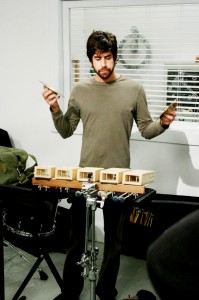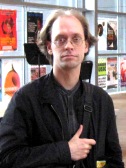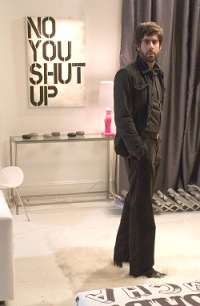
(UNTITLED), an original film satire of New York’s avant-garde art scene, will appear in theaters across the nation this fall. By poking fun at the idiosyncrasies of 21st century Bohemia, (UNTITLED) introduces American audiences to some of the best that contemporary art has to offer, notably a score by Pulitzer Prize-winning composer David Lang, who merges the artistic expressions of the composer protagonist with his own musical voice.
(UNTITLED) revolves around melancholy composer Adrian (Adam Goldberg) and his whirlwind affair with a Chelsea gallerist (Marley Shelton), who unbeknownst to Adrian sells vacuous commercial works to high-paying corporate clients. The film explores the idea of true art and the question of integrity lost through commercialism – all with tongue in cheek. At the beginning, Adrian’s music comprises cliché contemporary classical music elements, such as crinkling paper and breaking glass. Once his perspective and emotions achieve depth and insight through his blossoming romance, his music becomes more profound.
John Clare had a chance to send questions to both David Lang and Adam Goldberg. In the second part (part 1 is here with David Lang), John Clare finds out more about (UNTITLED) from its star, Adam Goldberg.
1. Often with a joke, there is some seriousness or truth behind it. Is there some truth to this movie even though there is some fun being poked?
Well, actually upon my last viewing of it, the second time I watched it with an audience, albeit at LACMA–the perfect audience–it seemed to have a real weight to it. The film sort of takes a turn once the absurdity is established I think. For me the film really has always been about this righteous indignation, this sort of defensiveness of one’s position–whether as an artist or a audience member or a critic or an art dealer, in this case–that really is front for enormous insecurity. These characters are all wayward and tend to overcompensate with very stringent , often absurd, points of view.
2. There are some outrageous sounds and art. How does your taste run in real life – in both “new concert music” and “art”?
I definitely have always been obsessed with sound and strange sounds and repetition, but usually incorporated into something melodic or hypnotic in some way. I have for a long time been a fan of Steve Reich–whose work began with simple tape loops and phasing of found material, but eventually he applied this process to beautiful symphonic pieces. I have also been a fan of some conceptual art, but usually when it engages the viewer, interacts with him or her in some way or tells a story. I don’t like things that seem to aim merely to shock or to alienate. Basically if it moves me or I can relate to it in some way then, well, I like it.
3. David Lang is a Pulitzer Prize winner and incredibly gifted composer, but unfortunately not a household name – how was he chosen for the movie, and how was collaboration with Untitled?
I believe Jonathan, the director, knew David from music school. He had an interesting job, both to score the film and create the ‘sound’ pieces our little group performs–though in the end it was so bizarrely structured and arranged that we could often only barely perform to playback so much of the “music” we’re making we actually are making. David also served I think as a bit of a consultant to Jonathan when he was writing this, creating my character. I love David’s music and this score is quite beautiful I think.
4. What is the possibility of Untitled 2, or Untitled – the Showtime series?
Ha!
5. There have been quite a few composers in pop culture these days, from “Forgetting Sarah Marshall” (Jason Segal) to “Mr. Magorium’s Wonder Emporium” (Natalie Portman’s piano/composer) and the likes of Paul McCartney & Billy Joel writing new classical music. Is composition a new cool as nerds (think Big Bang Theory) are?
Hmmm….I’ve never thought “Big Bang Theory.” Well, I remember years ago Elvis Costello put out a sort of classical record with the Brodsky Quartet that was pretty innovative. Conversely, Philip Glass many many years ago started I think to incorporate a sort of popular music element–singing an so forth–into his music. I think there’s always been some overlap. I saw a great piece that a childhood friend of my girlfriend’s put on. Michael Einziger from Incubus of all things. It was fantastic, sort of Reich meets Bernard Hermann. I think there’s something that feels for lack of a better word “legitimate” about working with classical elements. I know that some of the stuff musically I’ve done musically, with my project LANDy, that I’ve been most proud of incorporates some classical elements–arrangements of strings and that sort of thing. Albeit I’m usually humming the arrangements like a crazy person to the poor violinists.
(UNTITLED) opens tomorrow, October 23rd, in a limited release; and the soundtrack is out already from Cantaloupe!
 Many of our regular s21 readers should be familiar with Amsterdam’s own
Many of our regular s21 readers should be familiar with Amsterdam’s own 


 For a lot of you Vancouver, British Columbia is one of those “way out there” places. But coming from its U.S. “way out there” sister Seattle, I know that the art and music scenes are anything but moribund (though the Canadian government seems
For a lot of you Vancouver, British Columbia is one of those “way out there” places. But coming from its U.S. “way out there” sister Seattle, I know that the art and music scenes are anything but moribund (though the Canadian government seems  Many of us can recall a time, back in the day, when we brought cups of strong coffee to class and heard a professor tell us about the distant early days of “new music”. Long, long ago, in a galaxy far, far away (Italy),
Many of us can recall a time, back in the day, when we brought cups of strong coffee to class and heard a professor tell us about the distant early days of “new music”. Long, long ago, in a galaxy far, far away (Italy),  (UNTITLED), an original film satire of New York’s avant-garde art scene, will appear in theaters across the nation this fall. By poking fun at the idiosyncrasies of 21st century Bohemia, (UNTITLED) introduces American audiences to some of the best that contemporary art has to offer, notably a score by Pulitzer Prize-winning composer
(UNTITLED), an original film satire of New York’s avant-garde art scene, will appear in theaters across the nation this fall. By poking fun at the idiosyncrasies of 21st century Bohemia, (UNTITLED) introduces American audiences to some of the best that contemporary art has to offer, notably a score by Pulitzer Prize-winning composer  Ahead of its Oct 23rd general release date Adam Golberg, the actor who portrays all-too-well a modern “avant-something” composer/performer in the new film
Ahead of its Oct 23rd general release date Adam Golberg, the actor who portrays all-too-well a modern “avant-something” composer/performer in the new film  [Ed. note: Composer and S21 regular
[Ed. note: Composer and S21 regular